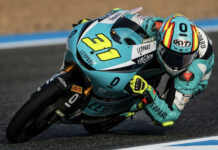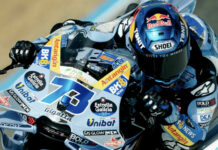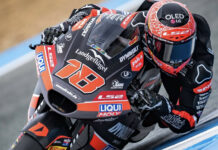At the start of the 2007 season Aprilia had won a total of 209 GP wins across all classes, with the majority of these coming while Jan was involved with the Aprilia factory, either as an engineer or racing department director. So what does this experienced engineer think of the proposed rule-changes to the 250cc class? “As it stands the current rules will remain until the end of 2009 then from 2010 it’s looking like the rules will change. The European factories want to carry on until around 2012 or 2014 as we feel we need more time to discuss the solution properly. I think the change has come about as Honda has announced that they will not be making any more two-stroke racing machines from 2010, so I think this is the reason why Dorna has chosen that year for the change.” What do you think will be the outcome of such a quick change to the rules? “I think it’s true that we could lose some of the smaller European factories which currently produce two-stroke 125 and 250cc machines. If you look at the situation at the moment we have Aprilia, KTM and then Gilera and Derbi. For sure, Gilera and Derbi are simply re-badged Aprilias, but it’s still important to see them out there. With Aprilia and KTM you at least have two major companies producing bikes in this class for the future.” What do you think are the major positive points for keeping the 250cc two-stroke category alive? “There are a number of reasons. As I’ve mentioned we don’t want to lose the European factories from this class. This could happen because of the cost. A 250cc machine is simply twice the number of cylinders that the 125cc machine has so there’s shared development costs. Proposed rules are possibly looking at a 600cc four-stroke powerplant, possibly a production motor in a prototype chassis. But none of the European manufacturers currently make such a motor: only the Japanese do, so from this point of view I think it’s crazy.” And you also think that the dynamics of the 250cc two-stroke racing machine helps the rider develop? “Of course! Look at today’s top MotoGP riders and they’re all from 250cc racing, Casey Stoner, Valentino Rossi. So far apart from Chris Vermeulen’s wet-weather win at Le Mans the winners have been from the 250cc class. Riders that are fast in 250s are fast in MotoGP, even riders like Randy de Puniet and Sylvain Guintoli have shown that they can adapt to a MotoGP bike. Riders such as John Hopkins have had to have more time to adapt. Even Nicky Hayden needed five years of investment from Honda and HRC before he took the title.” So why does a 250cc two-stroke help a rider develop? “It’s the sheer dynamics of the machine. You have a 100 kilo machine with plenty of horsepower and that engine itself is more dynamic than a four-stroke, in the way it makes its power. With a four-stroke the engine feels less rapid, but with a 250 you need to manage the throttle and the contact between the throttle and the rear wheel. This engine philosophy is very positive for the education of the rider. With a four-stroke I think that if the bike is on the limit or going in a certain direction you can change it more easily so you learn less about riding or setting a machine up. I believe if you cancel this class it will be very hard for teams to find the next generation of MotoGP riders. We have seen that the top three in 250cc can get on a MotoGP bike and ride it fast. The jump from a 125cc two-stroke machine to MotoGP would be too big.” What should be done then to keep the 250cc class as the ‘feeder’ class for MotoGP but allow the four-strokes in? “We know that not all companies want to make two-strokes, and we also know that for some factories most notably Ilmor, KTM and Aprilia it has been too expensive to carry on in the MotoGP class. So I think we should keep the two-strokes and allow a four-stroke in of, say, 50% of the current capacity of the MotoGP machines. That would mean a 400cc four-stroke machine which while more expensive to run than the 250cc two-stroke would effectively do what the 125cc class does now for the 250s, that is to reduce the development costs of the larger capacity class. This would make the 250/400cc class an entry class for companies that would eventually wish to compete in MotoGP. At the moment the risks and costs are too high for companies to come into MotoGP.” How much time do we have to make these changes or proposals? “Well, it’s an ongoing discussion at the moment so we’ve got about three years before the change so we need to agree these ideas soon. I think my proposal is a good solution which allows every company to compete with either a two-stroke or compete with a four-stroke.”
Jan Witteveen’s Opinion On The Future Of MotoGP’s Support Classes
Jan Witteveen’s Opinion On The Future Of MotoGP’s Support Classes
© 2007, Roadracing World Publishing, Inc.






